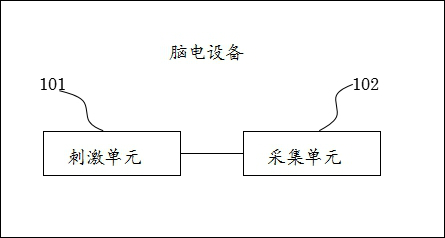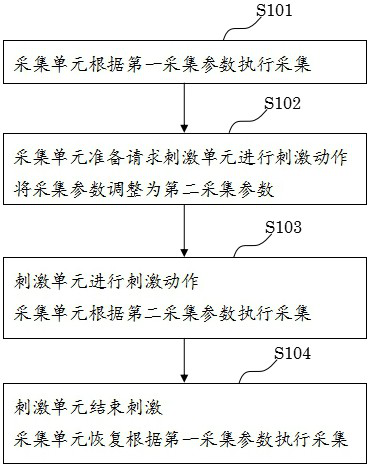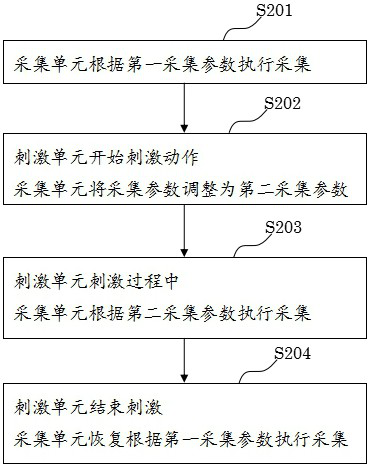EEG equipment, system, computer equipment and storage medium
An EEG system and EEG technology, applied in the field of electronic medicine, can solve problems such as signal aliasing, signal saturation, and the influence of brain physiological electrical signal acquisition.
- Summary
- Abstract
- Description
- Claims
- Application Information
AI Technical Summary
Problems solved by technology
Method used
Image
Examples
Embodiment 1
[0065] figure 2 The processing flow of Embodiment 1 of the present invention is shown. In Embodiment 1, the acquisition unit adjusts the acquisition operation during the stimulation process and the non-stimulation process according to the pre-stored acquisition parameters. Correspondingly, the EEG device may further include a storage unit for storing the first acquisition parameter and the second acquisition parameter. In an optional implementation manner, the acquisition unit may include the storage unit.
[0066] In Embodiment 1, the processing of the EEG device may include:
[0067] S101. During the non-stimulation process without stimulation, the acquisition unit 102 collects the human body according to the first pre-stored acquisition parameters (for example, the sampling rate is 1 kHz (ie, the first acquisition frequency), and the gain is 100 times (ie, the first signal gain)). Physiological electrical signals of the brain.
[0068] S102, the collection unit 102 pre...
Embodiment 2
[0073] image 3 The processing flow of Embodiment 2 of the present invention is shown. The difference between Embodiment 2 and Embodiment 1 is that in Embodiment 2, the stimulation unit 101 actively initiates stimulation. Specifically, the processing of the EEG device may include:
[0074] S201. During the non-stimulation process without stimulation, the acquisition unit 102 collects the human body according to the first pre-stored acquisition parameters (for example, the sampling rate is 1 kHz (ie, the first acquisition frequency), and the gain is 100 times (ie, the first signal gain)). Physiological electrical signals of the brain.
[0075] S202 , the stimulation unit 101 starts a stimulation action, and notifies the collection unit 102 . The acquisition unit 102 adjusts the acquisition parameters to the second acquisition parameters after receiving the notification from the stimulation unit 101 to initiate stimulation, for example, the sampling rate is 16 kHz (ie, the se...
Embodiment 3
[0080] Figure 4 The processing flow of Embodiment 3 of the present invention is shown. In embodiment 3, the processing of the EEG device includes:
[0081] S301. During the non-stimulation process without stimulation, the acquisition unit 102 acquires the human brain according to the first acquisition parameters (for example, the sampling rate is 1 kHz (ie, the first acquisition frequency), and the gain is 100 times (ie, the first signal gain)). Physiological electrical signal.
[0082] S302, the acquisition unit 102 prepares to request the stimulation unit 101 to perform a stimulation action, and adjusts the acquisition frequency to the acquisition frequency of a second acquisition parameter different from the first acquisition parameter, for example, it may be the maximum value supported by the system of the EEG device. In an optional implementation manner, the collection frequency of the second collection parameter may also be other values higher than the first collect...
PUM
 Login to View More
Login to View More Abstract
Description
Claims
Application Information
 Login to View More
Login to View More - R&D
- Intellectual Property
- Life Sciences
- Materials
- Tech Scout
- Unparalleled Data Quality
- Higher Quality Content
- 60% Fewer Hallucinations
Browse by: Latest US Patents, China's latest patents, Technical Efficacy Thesaurus, Application Domain, Technology Topic, Popular Technical Reports.
© 2025 PatSnap. All rights reserved.Legal|Privacy policy|Modern Slavery Act Transparency Statement|Sitemap|About US| Contact US: help@patsnap.com



